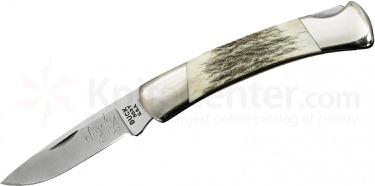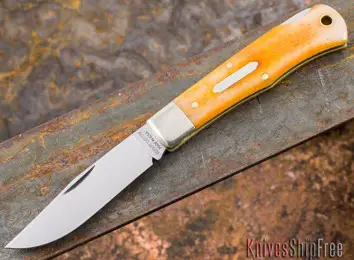|
Compared: Buck Model 503 Prince and GEC Tidioute #83 Tascola Lock Back Knives By Gary Zinn The opportunity to compare these two knives came about by happenstance. Some months ago, KnivesShipFree released a special run of the Great Eastern Cutlery (GEC) Tidioute Tascola and just a few weeks ago (as I write this in January, 2016) the Knife Center posted a vault find of an old limited edition of the Buck Prince. I jumped at the opportunity to buy both knives. I felt it would be interesting to compare the knives, since they are virtually identical in size and are both lock backs. Both are obviously designed to be compact pocket knives with light to medium duty cutting capabilities. Specifications: Buck Model 503 (as reviewed)  Buck Model 503 Elk Antler. Image courtesy of knifecenter.com.
Specifications: GEC Tidioute #83 Tascola (as reviewed)  GEC Tidioute #83 Camel Bone. Image courtesy of knivesshipfree.com.
Similarities and Differences Both knives have the same closed length, 3-3/8 inches. The images show that the handles have slightly different profiles and are finished out a bit differently, with front and back bolsters on the Buck, while the Tidioute has front bolsters only, plus a lanyard hole through the butt of the handle. There are profile differences in the blades. The Buck blade is a drop point, while that of the Tidioute is a clip. The blade on the Buck has a 2-3/8 inch total length, with 2 inches of sharpened edge. I measure the total length of the Tidioute blade at 2-5/8 inches (it was quoted as 2-1/2), with 2-7/16 inches of sharpened edge. Both blades are approximately 2mm thick at the spine, but the Tidioute blade is about 2mm wider than the Buck blade at the belly. The Buck blade is made of 420HC stainless steel, with a high hollow grind, while the Tidioute blade is 1095 carbon steel that is flat ground. Whether the dimensions, steel and grinds of the blades are significant differences depends, ultimately, on personal preferences. These are both meant to be handy pocket knives. The handle profiles and smoothed edges of both knives are certainly in this spirit, as is the fact that both knives weigh under two ounces. (I confirmed the weights listed above on a digital postal scale.) Both knives are easy to carry and have blade sizes that are capable of doing some work. The obvious difference between these knives is the handle scales. Further, the scales on each are not the materials normally used. The Buck knife has elk antler scales, while the Tidioute has lightly dyed camel bone. There is a back story in both cases. The Buck 503 Prince model was a special find and offering by the Knife Center, which they explained as follows: "KnifeCenter has come into a limited number of vintage Buck knives that contain a serious amount of history. These would be considered a vault find for us since they were made in 2003 and have never been removed from their boxes, until now. They were made in the old Buck factory located in El Cajon, CA before Buck's move to Idaho in late 2004. Each knife features the hand engraved signature of the late Chuck Buck and the date of '03'. This is your chance to own a piece of American knife history that is surely never to be seen again." I drank the Kool-Aid and the knife I got did not disappoint. It is exactly as described and the image shown above is very true to how the scales on my knife look. Also, you can make out the suggestion of the described engraving on the blade. This is sharp and clear on the actual knife. The #83 Tascola Lockback is a new factory pattern for Great Eastern Cutlery, first produced in 2015. The GEC website indicates that standard production runs of the pattern have been done with handle scales in cocobolo and ebony wood, jigged and smooth bone, linen Micarta, tortoise shell acrylic, and black (dyed) camel bone. There is a purple sage jigged bone handle style that is especially interesting, due to both the rich color of the scales and the jigging, an unusual cross between pickbone and Winterbottom. The Tidioute tang stamped knife I got was a SFO (special factory order) that GEC did for Derrick Bohn (KnivesShipFree). As the specs and image above indicate, this SFO was done with smooth camel bone scales, lightly dyed in a hue called "blood orange." I bit on this, because the handle scales are different and striking. Incidentally, the image is of the exact knife I bought. KnivesShipFree takes individual photos of upscale knives that have uniquely patterned handles and they post these so that a buyer can select the particular knife that most appeals; a great marketing technique. Images of dyed camel bone knife handles that I have seen have the characteristic shown in the image above. That is, the dyeing is not deep and uniform, but is more like a blush or wash, with the natural color of the camel bone showing through. This is much different from the normal heavy dyeing seen on cattle bone handle scales. I like it, as a change of pace. The other major difference between the Buck and GEC knives, as reviewed, is in pricing. The GEC Tidioute knife has both MSRP and street prices that are about twice the prices of the Buck model. These are really special editions of both knives, though. The standard Buck 503 Prince has a MSRP of $64, with a street price about $20 lower. This is for the model with stained Dymondwood handle scales and stainless steel bolsters. The standard production #83 Tascola knives have MSRPs generally $10 to $20 below the knife reviewed here, with street prices discounted by about one-third. The options do not end there, though. The Buck Prince can be custom ordered, directly from the factory, with nickel silver bolsters and four choices of solid wood handle scales for $71, water buffalo horn ($118), Elk antler ($128) or Sambar Stag ($163). Custom order options are listed on the Buck Knives website (www.buckknives.com). Fit, Finish and Function I found nothing worth criticizing about either fit of parts or finishing of the handle scales, bolsters, or blades of either knife. These knives are both as well done as one could wish for production knives. Both knives had factory edges that, out of the box, cleanly cut coated magazine paper. This is my standard test of factory edges. I call a blade that meets this test PDS (pretty darn sharp). Both knives have blade steels that are not hard to sharpen, so I would anticipate no problems in keeping them in top condition. I initially ran into function issues with both knives. The issue with the Buck was minor. I noticed that the blade resisted moving when I tried to close it. The lock seemed to be releasing okay, so I suspected that the pivot area was dry. After all, the knife had been in storage for over a decade. I put a drop of low viscosity fishing reel oil on the blade pivot area and let it sit for an hour. The blade moved fine after that. The functioning problem with the Tidioute was more significant. I could not unlock the blade with thumb pressure and lubrication did not help. The blade would open and lock as it should, but I had to press the back of the lock spring, hard, against the edge of a table to get it to release the blade. Great Eastern Cutlery is known for putting strong springs on their knives, but this was too much. I e-mailed GEC, explaining the problem. They replied that I should send them the knife for repair. Done and done, and the knife unlocks properly now. This was not an instant gratification situation, though. About three weeks after I mailed in the knife, I contacted GEC to make sure they had it. The reply was that it was in hand and waiting for someone to work on it. They explained that they do not have a repair department, as such, and that someone would see to my knife when they got a production run they were currently doing finished. It was another three weeks before that happened and they returned the knife to me. Perhaps GEC has not had enough returns to prompt them to assign a designated repair technician. Both knives lock securely and unlock cleanly now. The Buck has no blade play whatever with the blade locked open. The Tidioute blade has a minuscule amount of side play when open, but not enough to be worth worrying about. Conclusion The Buck Model 503 Prince and the Tidioute #83 Tascola are true to the design pioneered by the Buck Model 110 Folding Hunter. These are smaller knives than the Model 110, but they are still sturdy enough and have blade sizes sufficient to do serious light to medium cutting tasks. They are sized and shaped for easy pocket carry. With the basic Buck Prince, one can have a good, economical pocket-sized locking folder. Custom order Prince knives and the GEC #83 Tascola come into play, as knives with upscale handle treatments, for somewhat more money. Choice is a wonderful thing, but can sometimes pose a dilemma: so many knives, so little time. |